Source: Thailand Medical News Dec 02, 2019 5 years, 4 months, 2 weeks, 21 hours, 39 minutes ago
Most people, including doctors and
dentists, don't think much about
oral or mouth
cancer on a regular basis. Unfortunately, the death rate for oral cancer is higher than for any other type of cancer, including malignant melanoma, Hodgkin's lymphoma, and cervical and thyroid cancers.
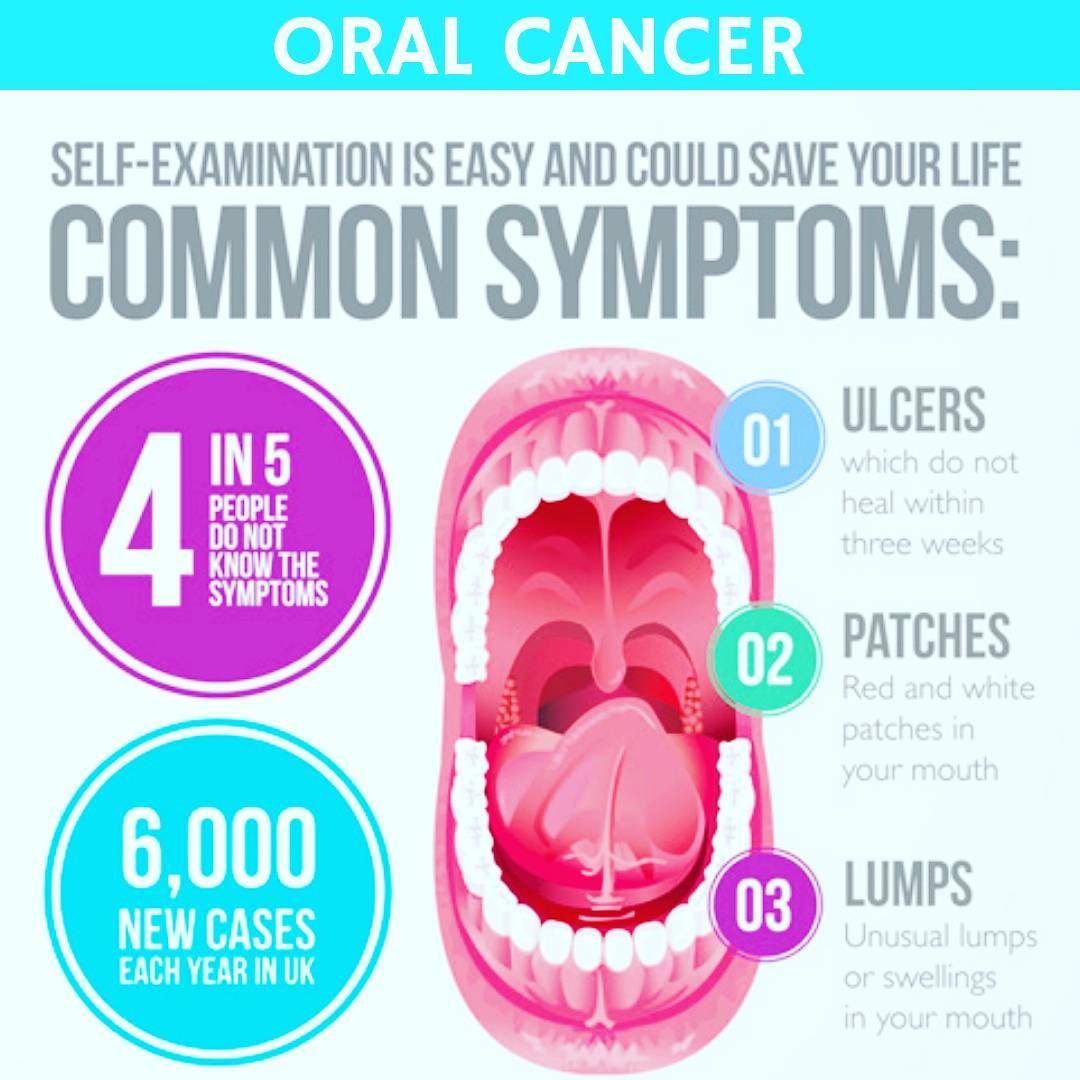 Oral cancer
Oral cancer is hard to detect because it is typically a small painless white or red spot in the mouth so this is easily ignored. Many people do not have regular dental care so this is not detected early. In fact, statistically, there is a poor prognosis for
oral cancer and this has not changed over the years as discovered by
Thailand Medical News.
Oral Cancer has High Death rate
Unfortunately the high death rate isn't because
oral cancer is hard to catch or necessarily difficult to remove, but because it's often caught too late. Over-scheduled doctors are so preoccupied with getting to all their patients in a timely manner, they forget or neglect to perform routine
oral cancer examinations. Our trust in doctors also contributes to the problem, with most believing that if the doctor says we are healthy, we are. Yet this is sometimes not the case. To combat cancer and other ailments, we must take our health into our own hands.
This DIY guide is in no way a substitute for regular dental check-ups and dental cleanings. However, it will teach you to keep a vigilant eye for anything abnormal in your mouth. Talk with your dentists about oral cancer the next time you go in, and be sure they do an oral cancer screening every six months.
In the meantime,
Thailand Medical News’ DIY Guide will help you to check for
oral cancer at home. It takes roughly two to three minutes.
Symptoms of Oral Cancer
If you are experiencing any of these symptoms, go to your dentist immediately.
- Mouth sores that don't heal within two weeks or start to bleed
- White, red, black, or discolored patches
- Swelling, lumps, bumps, or odd growths that are not found on both sides of the mouth
- Excessive or spontaneous bleeding or puss coming out of a lesion or open sore
- Difficulty or pain when swallowing
- Difficulty or pain when moving the jaw or tongue
- A constant feeling that something is stuck in your throat
- Continuous pain in the ear
- A persistent headache
Time See a Dentist
Make an appointment with a dentist or oral surgeon if you have any persistent signs and symptoms that bother you and last more than two weeks. It's important to get any spots checked out as well.
lor:#0000FF">DIY Guide For Checking For Mouth Or Oral Cancer At Home
Before we start on the actual check, one needs to understand that some things that you come across are actually normal. Oral health is a complex subject, and we can't touch on everything, but here's what you can expect to find:
- Linea Alba
- Parotid Papillae
- Fordyce Granules
- Swollen Lymph Nodes
- Exostoses
- Aphthous Ulcer
- Circumvallate Papillae
Linea Alba
This appears as thin white lines inside your cheeks. This is a normal, hyper-keratinezed area where you bite your cheeks, or where your cheeks rest between your teeth. The thin line will follow the biting plane or the area where your teeth meet.
.jpg) Linea alba is normal and is nothing to worry about.
Parotid Papillae
Linea alba is normal and is nothing to worry about.
Parotid Papillae
Also known as Stensen's duct, parotid papillae can be found inside your cheeks, toward the front of your mouth. It is a bump of extra tissue on the inside of each corner of your mouth. (You may sometimes bite them by accident.) These bumps are an outlet for your saliva glands and are normal, unless they are particularly hard.
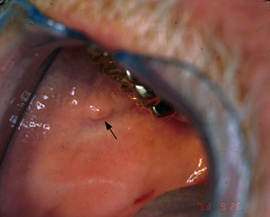 Fordyce Granules
Fordyce Granules
These are tiny white or yellowish-white spots on the inside of your cheeks or lips. They are nothing more than ectopic sebaceous glands, which are completely normal
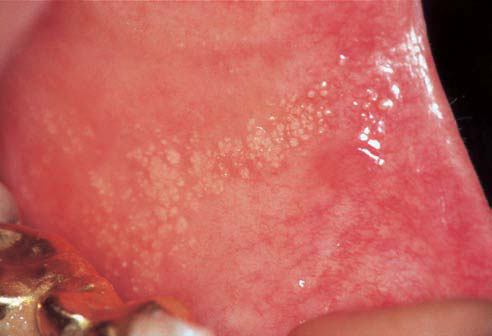 Fordyce granules are a normal finding
Swollen Lymph Nodes
Fordyce granules are a normal finding
Swollen Lymph Nodes
Swollen lymph nodes are often associated with illness or inflammation. If the swelling doesn't go away within a week or two, see a doctor. Places where lymph nodes are located include: the front and back of your neck; in front and behind your ears; in the cheek area; and on top of your shoulders. When swollen, they will often be sensitive or sore and may be visible.
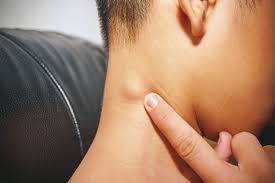 Exostoses
Exostoses
This is an extra bone growth commonly found under the tongue along the bony ridge, or on the hard palate. These growths may bulge out and are often rounded, sometimes involving a few bony lumps in one mass. The ones under the tongue are often found on each side of the face, while the ones on the hard palate are often singular.
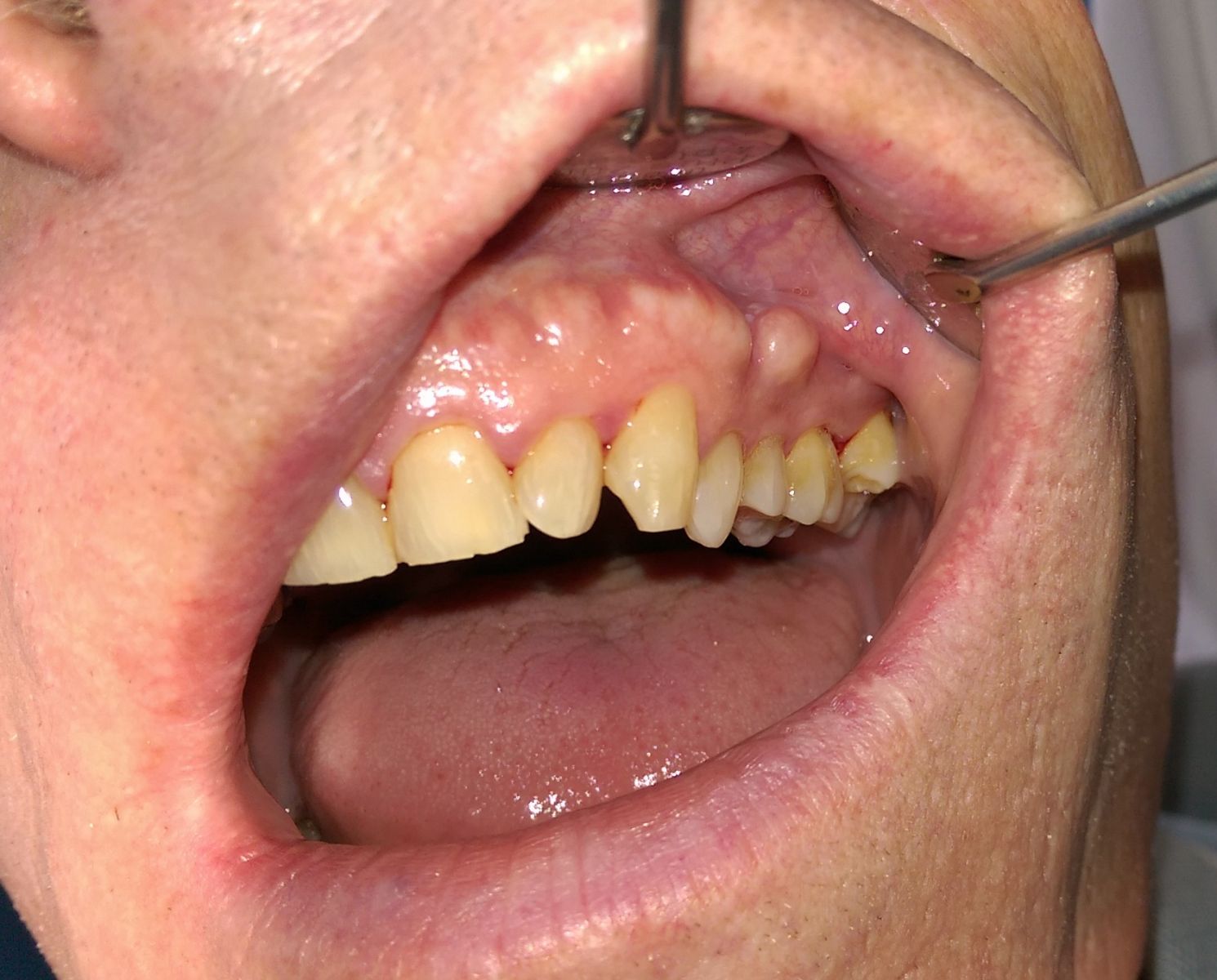 Aphthous Ulcer
Aphthous Ulcer
Also known as a canker sore, this is a small to medium, round ulcer. It usually has a white interior and a bright red border. They are very sensitive and can affect your oral hygiene and eating. They should go away within a week or two. Taking zinc will help speed up this process and will also help prevent future canker sores. If the ulcer does not go away within two weeks, you should contact your dentist.
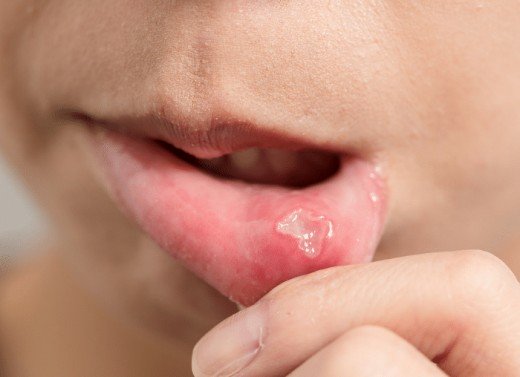 An aphthous ulcer (canker sore) is a normal finding.
Circumvallate Papillae
An aphthous ulcer (canker sore) is a normal finding.
Circumvallate Papillae
These are large, protruding bumps on the back of the tongue arranged in a V shape. They are the largest of the four types of taste buds, and most people have about 10 to 14 of them.
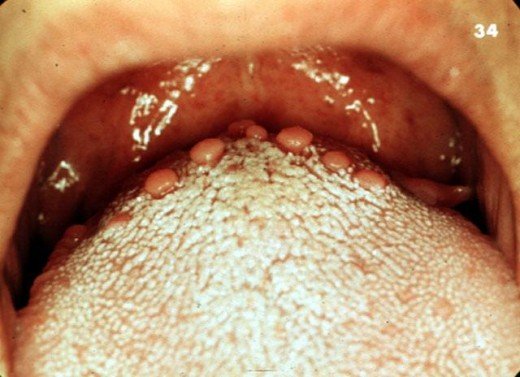 Circumvallate papillae (taste buds) - normal finding
Checking for Oral Cancer at Home
1. Check Your Lips
Circumvallate papillae (taste buds) - normal finding
Checking for Oral Cancer at Home
1. Check Your Lips
Use bi-digital palpation (pictured below), a tactile method of oral examination in which you use your thumb and forefinger to rule out abnormalities, to feel for any hard lumps or areas of soreness. Pinch your lip by placing your pointer finger on the inside of your mouth, and your thumb on the outside. Apply moderate pressure, pressing the lip tissue between your finger and thumb.
 Illustration depicting bi-digital palpation.
2. Check Your Cheeks
Illustration depicting bi-digital palpation.
2. Check Your Cheeks
Use bi-digital palpation to feel your cheeks. Feel for any hard lumps or areas of soreness.
3. Check the Floor of Your Mouth
Use bimanual palpation (pictured below) to feel the floor of your mouth, which is the area under your tongue. Place the pointer finger of one hand under your tongue, while pressing up with the thumb of the other hand on the outside of the jaw. Directly oppose the finger in your mouth. Feel for any hard lumps or areas of soreness. Press firmly.
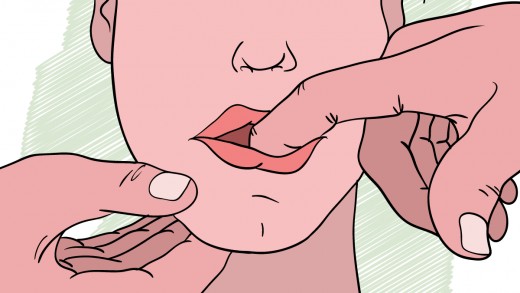 Illustration of bimanual palpation.
4. Check Your Tongue
Illustration of bimanual palpation.
4. Check Your Tongue
Use bi-digital palpation to feel your tongue. Stick your tongue out and palpate the body of the tongue, feeling for lumps or areas of soreness.
5. Examine the Surface of Your Tongue for Blemishes
Stick your tongue out, grab the tip, and look at each side for any anomalies. The sides of the tongue are the most common places to find oral cancer. Don't confuse varicosities, also known as veins, for something abnormal.
You may also see circumvallate papillae, which are large bumps at the back of the tongue. These are normal. If you notice they are enlarged, don't panic. This can be due to a number of reasons that aren't due to cancer. This includes a viral infection, an allergic reaction, a high-grade fever, a tissue injury, or a nutritional deficiency. However, circumvallate papillae may turn into a cancerous form if it grows enough to get involved with lymph nodes of that region, so it's important to talk to your doctor or dentist if you notice a change.
6. Say, "Ahh"
Stick your tongue out, say "Ahh," and look at your oropharyngeal area, also known as your tonsils, for any inflammation or sores. It is normal for some people's tonsils to have indented pockets in them. Look for features that seem inflamed or out of place, as this is not normal.
7. Check the Roof of Your Mouth
Tilt your head back and look at the roof of your mouth. Look for sores and inflammation. Rule out any burns you may have acquired from eating food that is too hot.
8. Check Your Gums
Pull out your lips and look very closely at your gums. Are there sores on your gums or patches of discolored tissue? Do your gums bleed when you lightly touch them or when they are not provoked at all?
Tip
If you notice anything that is concerning, take a picture (if you can) and compare it in a week or two.
Risk Factors of Mouth Cancer.
Known risk factors include tobacco and alcohol consumption, which, together, are responsible for abou 70 percent of
oral or
mouth cancer. There is a relationship between smoking and alcohol that has been well established. However, now there is also a correlation between HPV and throat or tonsillar cancer in younger people. Other factors include:
- Smoking
- Chewing betel nut
- Drinking alcohol
- HIV/AIDS
- The HPV-16 virus
- Aging
- Chronic mouth irritation
- Poor oral hygiene
How to Prevent Oral Cancer
- Stop using tobacco or don't start.
- Drink alcohol in moderation or don't drink at all.
- See your dentist regularly.
- Eat a well-balanced diet.
- Limit your exposure to the sun. Repeated exposure increases the risk of cancer on the lip, especially the lower lip.
Treatment Options
Surgery
This involves surgical removal of the tumor and a little bit of healthy tissue around it. If the tumor is small, this surgery will likely be minor, but for a bigger tumor, this could involve the removal of some of the tongue or parts of the jaw.
Radiation Therapy
Oral cancer is especially sensitive to radiation therapy and may be the only necessary treatment for those with early-stage cancer. However, it may also be used in combination with surgery and/or chemotherapy if the cancer is more advanced.
Chemotherapy
If the cancer is more widespread, chemotherapy may be used.
Oral Cancer Facts and Statistics
- Oral cancer is a common cancer of global concern.
- Early detection has the potential to significantly reduce death and morbidity.
- There is an alarming increase in oropharyngeal cancer cases seen in the 18 to 40 age group.
- Oral cancer is usually completely painless in its early stages.
- About 135,000 people globally and 8,000 people in the US will die of oral cancer this year.
- 40,000 Americans will be diagnosed with oral or pharyngeal cancer this year.
- Of the all the people diagnosed, only 57% will still be alive in five years.
- Approximately Us$3.2 billion is spent on oral cancer in the US alone per year.
- Worldwide, 640,000 people will be diagnosed this year.
- Late stage discovery is not the exception, it is the norm.
- Discovery of oral cancer at a late stage usually means it has already spread to the larynx and other secondary locations.
- When discovered at a late stage, the chance of a recurrence is multiplied 20-fold for the next ten years.
- Around 90% of oral cancers are squamous cell carcinomas, originating in the tissues that line the mouth and lips.

.jpg)







